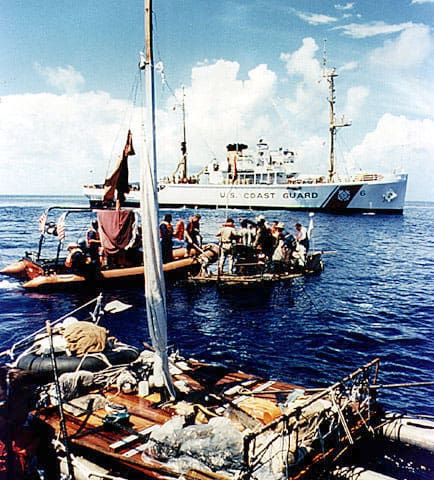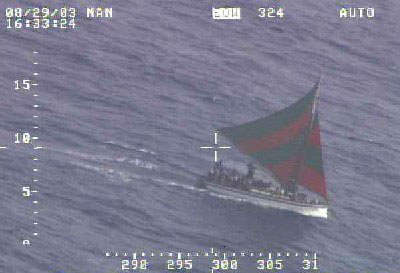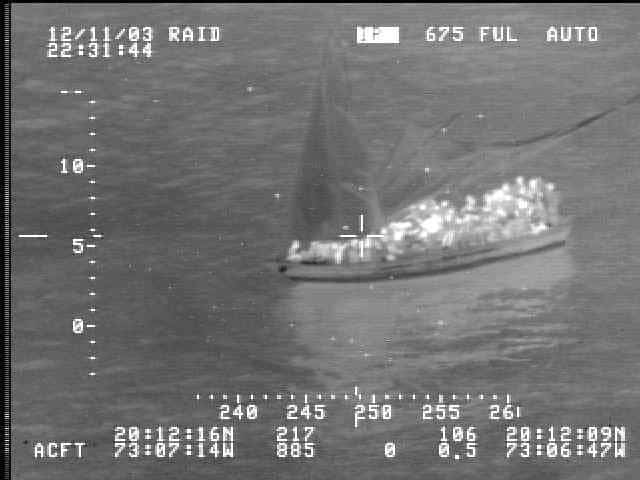In 1994 the Coast Guard was involved in its largest operation since the war in Vietnam. Responding to two mass migrations at the same time – first from Haiti and then from Cuba. Over 63,000 migrants were rescued and prevented from illegally entering the United States during Operation ABLE MANNER and Operation ABLE VIGIL. At its height, ABLE MANNER involved 17 Coast Guard cutters, nine aircraft and five US Naval ships patrolling the coast of Haiti while ABLE VIGIL involved 29 Coast Guard cutters, six aircraft, and nine US naval ships patrolling the Straits of Florida.
Guantanamo Bay, Cuba

A military lead coup overthrew the elected government of Jean Bertrand Aristide, the first democratically-elected president in Haitian history, on September 30, 1991. Despite the coup, there was no immediate exodus. Then in late October the first boatload was intercepted carrying a small number of people. Following the established practice, the passengers were taken on board the Coast Guard cutter and interviewed for “refugee-like characteristics” by Immigration and Naturalization Service (INS) officers flown to the cutter by helicopter. Policy makers in Washington, DC were concerned over events in Haiti and because of the sensitive nature of the situation final refugee status determination was to be made in Washington.
By early November an increased number of Haitian vessels were interdicted and as one cutter became crowded, additional cutters were brought into the area. By mid-November several hundred Haitians were on Coast Guard Cutters circling in international waters between Haiti and Cuba. On 18 November the government announced that the program of forced repatriation of “screened-out” Haitians would resume. The next day the first of what would become many legal challenges against the government were filed. The judge in the case suspended all forced repatriations until February 1992. Consequently; a tent camp at the U.S. Naval Station at Guantanamo Bay, Cuba was opened to accept the migrants. Hundreds and then thousands of Haitian migrants were interdicted and brought for further processing. This program ended when President Bush issued Executive Order 12807 authorizing the repatriation of interdicted Haitians to Haiti to pursue their claims through in-country U.S. refugee processing established under section 101(a)(42)(B) of the INA.
Operation ABLE MANNER
This operation commenced in January of 1993. It concentrated Coast Guard patrols in the Windward Passage, the body of water between Haiti and Cuba, interdicting Haitian migrants and returned them to Haiti. Both fixed wing and helicopter aircraft, supported out of Coast Guard AVDET Guantanamo Bay, were used to enhance the surveillance capabilities of the surface vessels. A total of 14,000 flight hours were expended during the interdiction operation.
 As events in Haiti continued to unfold, the Coast Guard was a full participant in the plans to forcibly occupy the island. As one of the Armed Forces the Coast Guard air and sea assets were used where appropriate. Of particular value was Coast Guard aviation’s familiarity with night, over water operations, and the sensor capabilities of its aircraft. When the plan was formed to move a large force of Army helicopters from South Florida to Great Inagua in the Bahamas, the essential job of Search and Rescue went to the Coast Guard. This night time helicopter movement positioned a critical portion of the helicopter assets for the planned invasion. Coast Guard helicopters provided navigation and escort, while HC-130s and cutters performed duckbutt duties during the movement. In addition, a Coast Guard C-130 performed a covert insert of an Air Force Aircraft Control Unit. The Coast Guard air station at Borinquen, Puerto Rico was designated and equipped as the emergency divert base for any C-141 or C-5 experiencing problems. The Coast Guard CASA 212 took pictures of the facilities at Port au Prince during a series of diplomatic flights. Coast Guard surface units also had many roles.
As events in Haiti continued to unfold, the Coast Guard was a full participant in the plans to forcibly occupy the island. As one of the Armed Forces the Coast Guard air and sea assets were used where appropriate. Of particular value was Coast Guard aviation’s familiarity with night, over water operations, and the sensor capabilities of its aircraft. When the plan was formed to move a large force of Army helicopters from South Florida to Great Inagua in the Bahamas, the essential job of Search and Rescue went to the Coast Guard. This night time helicopter movement positioned a critical portion of the helicopter assets for the planned invasion. Coast Guard helicopters provided navigation and escort, while HC-130s and cutters performed duckbutt duties during the movement. In addition, a Coast Guard C-130 performed a covert insert of an Air Force Aircraft Control Unit. The Coast Guard air station at Borinquen, Puerto Rico was designated and equipped as the emergency divert base for any C-141 or C-5 experiencing problems. The Coast Guard CASA 212 took pictures of the facilities at Port au Prince during a series of diplomatic flights. Coast Guard surface units also had many roles.
The operation was originally planned as a forced invasion but it became a permissive entry operation. The Coast Guard Cutter Chase was the first ship into the Port au Prince Harbor.
Haitian migrants still leave Haiti attempting to reach the U.S. Many travel to the Bahamas and enter on smaller boats, while some attempt direct entry to the U.S. in large boat loads. There is a Coast Guard Liaison Officer at the U.S. Embassy in Port au Prince, Haiti, who handles various migration, counter-drug, and international engagement issues with Haiti.
Operation ABLE VIGIL
During the summer of 1994 a Cuban tugboat and several ferries were hijacked by Cuban migrants trying to leave the country. On August fifth crowds numbering in the hundreds gathered in Havana drawn by the news of the ferry hijackings. Confrontations with the police occurred. Castro again took advantage of the situation blaming the clashes on the United States and warned that Cuba would stop putting obstacles in the way of Cubans trying to leave the island if Washington did not change its immigration policy. The United States said it would not allow a repeat of the Mariel boatlift of 1980. The Cuban security forces were ordered to monitor but to not facilitate nor obstruct illegal maritime departures. This resulted in a number of people leaving Cuba in small boats and rafts. In response to an increase in Cuban migration, Coast Guard patrols were enhanced to rescue these people and to deter potential U.S. vessels from going to Cuba to make pick-ups.
On 19 August the Coast Guard initiated ABLE VIGIL in response to uncontrolled migration from Cuba. President Clinton announced that undocumented Cuban migrants would be prohibited entry into the United States and those intercepted would be transported to safe havens. Several Latin American and Caribbean nations expressed a willingness to shelter Cuban refugees led by Panama’s offer to take 10,000 and Honduras’ announcement that they would accept up to 5,000. Guantanamo Bay was utilized to shelter the remainder. The Chairman of the Joint Chiefs of Staff ordered Department of Defense (DOD) assets into action to support ABLE VIGIL. This included US Navy units to transport migrants; US Army units to construct and provide security at migrant camps; US Marine Corps units to provide security at Guantanamo Bay, Cuba; and US Air Force units to transport DOD assets to Guantanamo Bay and Cuban migrants to Panama. The Coast Guard established an effective “barrier patrol” of cutters supported by aircraft. During the week of 22 August, 10 more Cubans were interdicted than had been rescued during the previous decade. Fidel Castro issued a directive to his security forces on September 11 to prevent further illegal maritime departures. During Operation ABLE VIGIL 30,224 Cuban migrants were interdicted.
HC-130, HU-25, HH-60 and HH65 aircraft from Miami and Clearwater air stations were utilized and flew in excess of 1,200 total hours.
The United States Cuban immigration policy was changed. In negotiations with Cuba the United States agreed to allow 20,000 Cubans to immigrate each year. In return Cuba pledged to stop any further exodus of Cubans aboard makeshift rafts and small boats trying to reach the shores of Florida. All others who attempted to illegally migrate and were picked up at sea would be taken back to Cuba. Those who reached U.S. soil would be allowed to stay. On April 25 1995, the remaining 21,000 refugees remaining at Guantanamo Bay were allowed to resettle in the United States.


